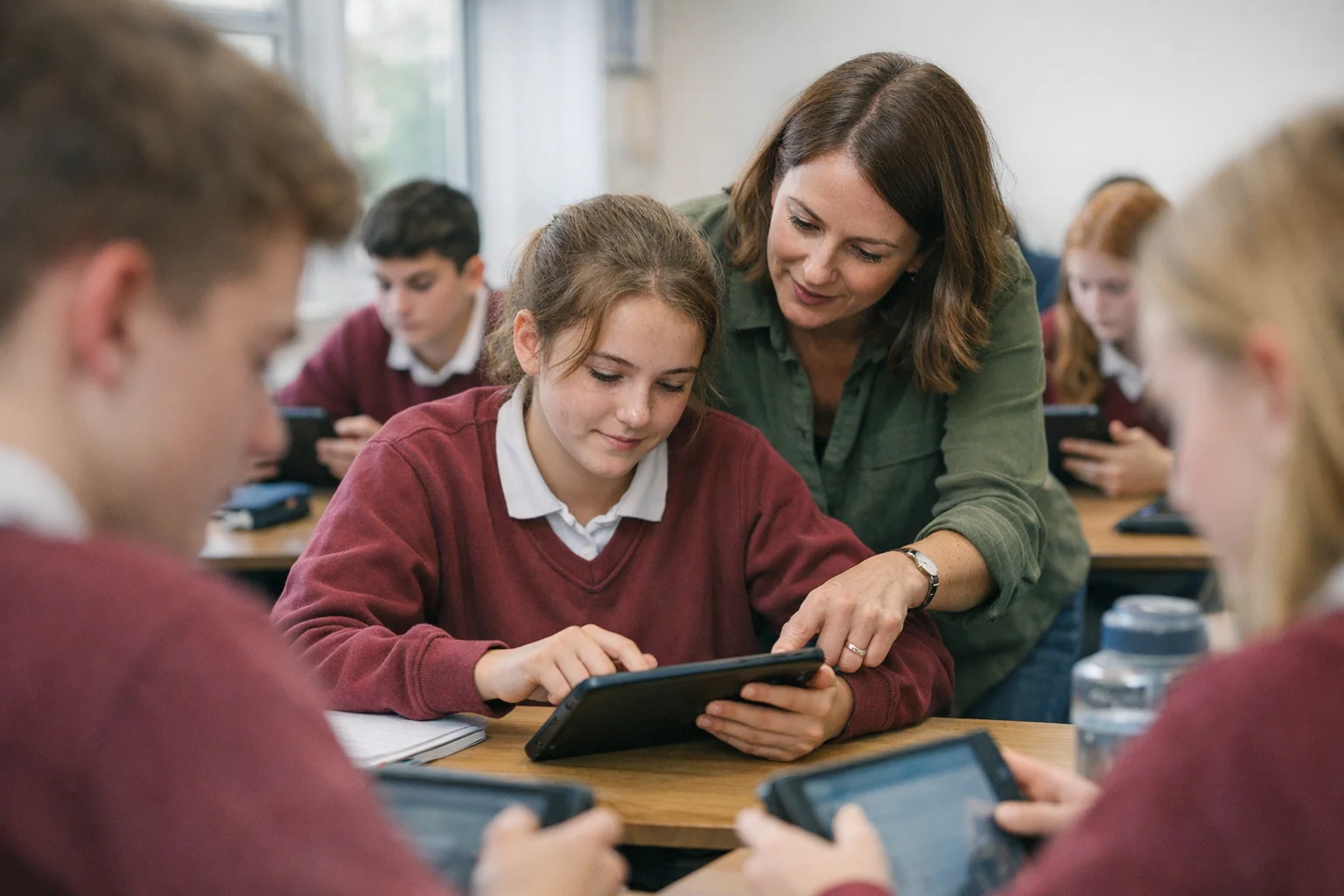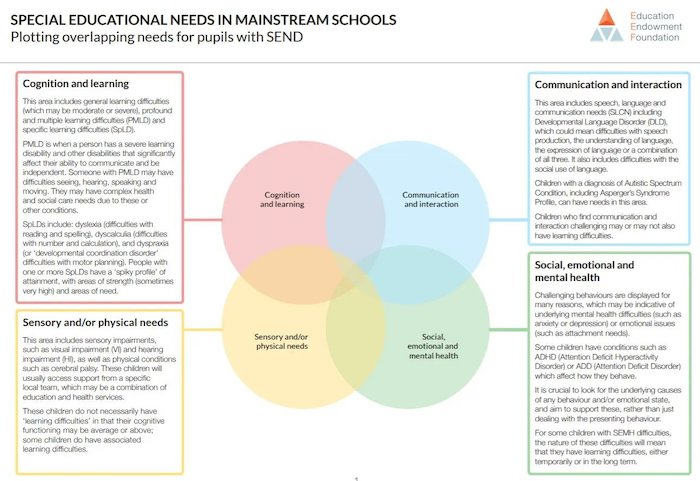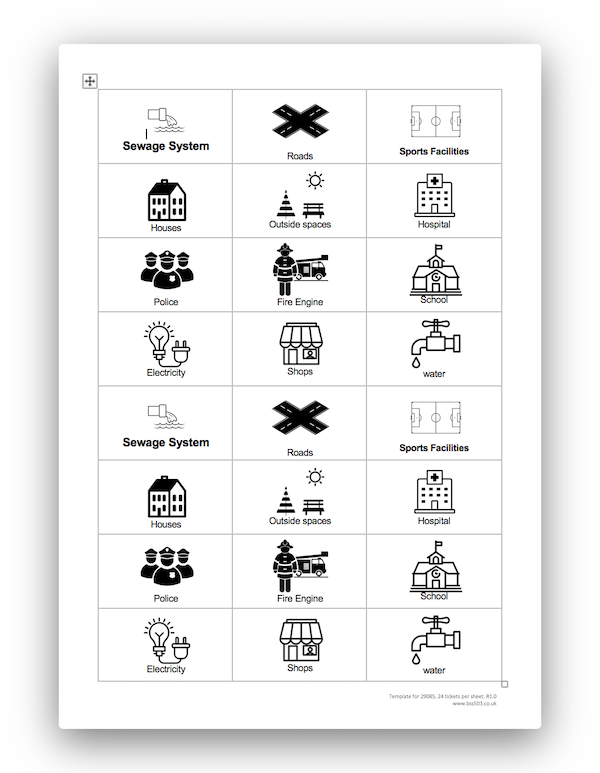Special Educational Needs
|
August 18, 2022
Creating inclusive learning environments for children with Special Educational Needs.


|
August 18, 2022
Creating inclusive learning environments for children with Special Educational Needs.
Every child in the world has strengths and weaknesses, and each child will prosper under different conditions. There is a lot of debate about special education needs students. Are these children incapable of learning as well as their mainstream peers and can specialized educational provision really remove the progress barriers they face? We shall discuss specific educational needs in full in this article and hopefully provide an overall big picture of this complex domain.
When a child has an additional learning difficulty or disability, which creates additional barriers to learning based on their age range. This is referred to as Special Education Needs (SEN). Some children may have trouble coping with their regular school day activities, such as finishing their schoolwork, communicating with others, or acting improperly and they may require an educational, health and care plan to meet their needs.
In this article, we will discuss what an inclusive education means and how every classroom can make learning accessible. We will explore strategies for creating inclusive classrooms that support all learners. We will begin the article by outlining the wide range of additional learning needs. Being able to provide suitable SEN provision requires us to have a good conceptual understanding of the sheer breadth of access needs. The class teacher, along with the SENDCo, often have to dig a bit deeper to get to the underlying issue the child is facing. The classroom behaviours don't always tell us the true picture and that's why it's important to involve specialists from the outset.
A person with SEN may fall into at least one of these four groups, according to the Children and Families Act (DfE, 2014a):
1. Communication and Interaction: problems interacting with, reacting to, and understanding spoken language, such as speech problems or autism.
2. Cognition and Learning needs: It is primarily a problem with the taught curriculum, such as dyslexia (reading and spelling), dyscalculia (mathematics), dyspraxia (coordination), or dysgraphia (writing). Which may requires different types of support such as one-to-one support or group support.
3. Social, mental, and emotional health: attention deficit disorder (ADD), attention deficit hyperactivity disorder (ADHD), or autism, for example, cause problems in managing and expressing emotions and behavioural difficulties.
4. Sensory and/or Physical Needs: physical and sensory difficulties such as visual impairment (VI), hearing impairment (HI), multi-sensory impairment (MSI), or physical disability.
Additionally, some children who are regarded as 'gifted and talented' may require SEN additional SEN support to suit their needs. Special education needs include not just the obstacles that students may face, but also children that their potential above their age range.

Access Arrangements/ Accommodations:
Students with special needs might require access arrangements that includes accommodations in class and during exams. The concept of this approach takes into account the student's additional learning challenges. Arrangements for access include:
Differentiated Instruction:
During the learning process, the teacher should ensure that all students are given an equal opportunity to have an access to the learning experience. Differentiated instruction is one technique to make learning experience more accessible to students.
Instructions, outcomes, activities, and resources should all be differentiated. Instead of focusing on a child's limitations, differentiation seeks to focus on his or her learning preferences, strengths, and abilities. Less or more structure and tasks should be provided to students by their teachers. 'Gifted' students might be included in differentiated instruction.
Grouping Students:
Groups can help students who need extra assistance. Grouping students helps them to learn better. In addition, grouping students can help teachers to identify students' strengths and weaknesses. This might not form part of a school's philosophy of education, but it could mean meeting the additional learning needs of a child more effectively.
Primary-age children should not have to be removed from classrooms and restricted to working every hour in the corridor, but effective SEN provision might sometimes mean considering the concentration levels of individual learners and making appropriate instructional changes.
Inclusion:
The inclusion model focuses on providing services to all students. This means that every student has the same opportunities to succeed. All students are expected to participate in the classroom activities and receive the same level of academic support.
The inclusion model is based on the belief that all students can learn if they are given the right tools and opportunities. It is important to note that some students will benefit from being grouped together while others will benefit from being taught individually.

Assessment:
Assessments should be used to determine whether the students are making progress towards their goals. Assessments should be done regularly so that the teachers can provide appropriate feedback to the students. Teachers should assess students using different methods including observation, tests, interviews, portfolios, and other assessment techniques.
Individual Education Plan (IEP):
Teachers and participants must collaborate with parents and learners to create and design alternative / additional provision for students with special education needs. All areas of the pupil's well-being during the school day should be addressed in the IEP. Setting up a behaviour support service, additional SEN provision, speech therapy, health and care plans or accommodation advice for exams are all ideas that need to be included in the IEP.
Modification:
Changing educational settings and assessment process to ensure that students have access to learning based on their abilities. Modify the objectives, for example.
Pragmatics:
It is a part of linguistics that deals with language and communication. This can lead to communication problems, inability to obey verbal directions and norms, inability to keep a conversation on track, or improper communication styles.
Psycho-educational assessment:
It is a method of acquiring and analysing data on a student's strengths and weaknesses. It necessitates the implementation of a particular test to assess additional learning demands, intellectual capacities, or to detect problems. This will make it easier to identify and provide the student with the required SEN provision.
Scaffolding:
Is the process of teaching a pupil tactics and strategies that will help them study more effectively and independently. Teach the student to underline keywords, break down the activity into little chunks, or make a to-do list to organise their time, for example. The scaffolding should be gradually eliminated once the student is able to work independently.

Universal Intervention: Low Need
Targeted Intervention for a Medium-Needed Population
Specialist Intervention is Required in Cases of Extreme Need.
Some of the current thinking around catering for specific learning needs is to make classrooms inclusive for everyone. This effectively means creating a philosophy of education where everyone has access to the same opportunities and our job as educators is to reduce these barriers to learning.
One example of this would be to use more visual material that everyone accesses. In this example, the dyslexic students are not restricted to using image-based materials and their peers use text-based materials, everyone receives the same accessible guidance in a pictorial format. This type of approach might reduce the stigma of providing additional SEN support as it's not clear as to who the intervention is for as everyone receives the same type of experience.
The importance of inclusive education for SEN students should be considered when discussing students with special needs. Every child should be able to enter and participate in the educational setting. The whole class should be involved in the learning environment with a well-designed inclusive education. The school must ensure that it creates a secure atmosphere that meets the academic, emotional and social development of the SEN students. The school also ensures that parents and employees have the necessary assistance to participate in the inclusive practice.

Reference:
https://www.nidirect.gov.uk/articles/children-special-educational-needs
https://technologyforlearners.com/an-overview-of-the-most-common-special-educational-needs-sen-symptoms-strategies/
https://www.cambridgeinternational.org/images/271195-special-educational-needs.pdf
https://blog.innerdrive.co.uk/5-ways-to-support-sen-students-in-the-mainstream-classroom
https://www.extendednotes.com/after-school-articles/5-things-you-need-to-create-an-inclusive-environment-for-students-with-adhd
https://www.kennedykrieger.org/stories/linking-research-classrooms-blog/supporting-inclusive-education-students-autism-spectrum-disorder-part-ii
Every child in the world has strengths and weaknesses, and each child will prosper under different conditions. There is a lot of debate about special education needs students. Are these children incapable of learning as well as their mainstream peers and can specialized educational provision really remove the progress barriers they face? We shall discuss specific educational needs in full in this article and hopefully provide an overall big picture of this complex domain.
When a child has an additional learning difficulty or disability, which creates additional barriers to learning based on their age range. This is referred to as Special Education Needs (SEN). Some children may have trouble coping with their regular school day activities, such as finishing their schoolwork, communicating with others, or acting improperly and they may require an educational, health and care plan to meet their needs.
In this article, we will discuss what an inclusive education means and how every classroom can make learning accessible. We will explore strategies for creating inclusive classrooms that support all learners. We will begin the article by outlining the wide range of additional learning needs. Being able to provide suitable SEN provision requires us to have a good conceptual understanding of the sheer breadth of access needs. The class teacher, along with the SENDCo, often have to dig a bit deeper to get to the underlying issue the child is facing. The classroom behaviours don't always tell us the true picture and that's why it's important to involve specialists from the outset.
A person with SEN may fall into at least one of these four groups, according to the Children and Families Act (DfE, 2014a):
1. Communication and Interaction: problems interacting with, reacting to, and understanding spoken language, such as speech problems or autism.
2. Cognition and Learning needs: It is primarily a problem with the taught curriculum, such as dyslexia (reading and spelling), dyscalculia (mathematics), dyspraxia (coordination), or dysgraphia (writing). Which may requires different types of support such as one-to-one support or group support.
3. Social, mental, and emotional health: attention deficit disorder (ADD), attention deficit hyperactivity disorder (ADHD), or autism, for example, cause problems in managing and expressing emotions and behavioural difficulties.
4. Sensory and/or Physical Needs: physical and sensory difficulties such as visual impairment (VI), hearing impairment (HI), multi-sensory impairment (MSI), or physical disability.
Additionally, some children who are regarded as 'gifted and talented' may require SEN additional SEN support to suit their needs. Special education needs include not just the obstacles that students may face, but also children that their potential above their age range.

Access Arrangements/ Accommodations:
Students with special needs might require access arrangements that includes accommodations in class and during exams. The concept of this approach takes into account the student's additional learning challenges. Arrangements for access include:
Differentiated Instruction:
During the learning process, the teacher should ensure that all students are given an equal opportunity to have an access to the learning experience. Differentiated instruction is one technique to make learning experience more accessible to students.
Instructions, outcomes, activities, and resources should all be differentiated. Instead of focusing on a child's limitations, differentiation seeks to focus on his or her learning preferences, strengths, and abilities. Less or more structure and tasks should be provided to students by their teachers. 'Gifted' students might be included in differentiated instruction.
Grouping Students:
Groups can help students who need extra assistance. Grouping students helps them to learn better. In addition, grouping students can help teachers to identify students' strengths and weaknesses. This might not form part of a school's philosophy of education, but it could mean meeting the additional learning needs of a child more effectively.
Primary-age children should not have to be removed from classrooms and restricted to working every hour in the corridor, but effective SEN provision might sometimes mean considering the concentration levels of individual learners and making appropriate instructional changes.
Inclusion:
The inclusion model focuses on providing services to all students. This means that every student has the same opportunities to succeed. All students are expected to participate in the classroom activities and receive the same level of academic support.
The inclusion model is based on the belief that all students can learn if they are given the right tools and opportunities. It is important to note that some students will benefit from being grouped together while others will benefit from being taught individually.

Assessment:
Assessments should be used to determine whether the students are making progress towards their goals. Assessments should be done regularly so that the teachers can provide appropriate feedback to the students. Teachers should assess students using different methods including observation, tests, interviews, portfolios, and other assessment techniques.
Individual Education Plan (IEP):
Teachers and participants must collaborate with parents and learners to create and design alternative / additional provision for students with special education needs. All areas of the pupil's well-being during the school day should be addressed in the IEP. Setting up a behaviour support service, additional SEN provision, speech therapy, health and care plans or accommodation advice for exams are all ideas that need to be included in the IEP.
Modification:
Changing educational settings and assessment process to ensure that students have access to learning based on their abilities. Modify the objectives, for example.
Pragmatics:
It is a part of linguistics that deals with language and communication. This can lead to communication problems, inability to obey verbal directions and norms, inability to keep a conversation on track, or improper communication styles.
Psycho-educational assessment:
It is a method of acquiring and analysing data on a student's strengths and weaknesses. It necessitates the implementation of a particular test to assess additional learning demands, intellectual capacities, or to detect problems. This will make it easier to identify and provide the student with the required SEN provision.
Scaffolding:
Is the process of teaching a pupil tactics and strategies that will help them study more effectively and independently. Teach the student to underline keywords, break down the activity into little chunks, or make a to-do list to organise their time, for example. The scaffolding should be gradually eliminated once the student is able to work independently.

Universal Intervention: Low Need
Targeted Intervention for a Medium-Needed Population
Specialist Intervention is Required in Cases of Extreme Need.
Some of the current thinking around catering for specific learning needs is to make classrooms inclusive for everyone. This effectively means creating a philosophy of education where everyone has access to the same opportunities and our job as educators is to reduce these barriers to learning.
One example of this would be to use more visual material that everyone accesses. In this example, the dyslexic students are not restricted to using image-based materials and their peers use text-based materials, everyone receives the same accessible guidance in a pictorial format. This type of approach might reduce the stigma of providing additional SEN support as it's not clear as to who the intervention is for as everyone receives the same type of experience.
The importance of inclusive education for SEN students should be considered when discussing students with special needs. Every child should be able to enter and participate in the educational setting. The whole class should be involved in the learning environment with a well-designed inclusive education. The school must ensure that it creates a secure atmosphere that meets the academic, emotional and social development of the SEN students. The school also ensures that parents and employees have the necessary assistance to participate in the inclusive practice.

Reference:
https://www.nidirect.gov.uk/articles/children-special-educational-needs
https://technologyforlearners.com/an-overview-of-the-most-common-special-educational-needs-sen-symptoms-strategies/
https://www.cambridgeinternational.org/images/271195-special-educational-needs.pdf
https://blog.innerdrive.co.uk/5-ways-to-support-sen-students-in-the-mainstream-classroom
https://www.extendednotes.com/after-school-articles/5-things-you-need-to-create-an-inclusive-environment-for-students-with-adhd
https://www.kennedykrieger.org/stories/linking-research-classrooms-blog/supporting-inclusive-education-students-autism-spectrum-disorder-part-ii